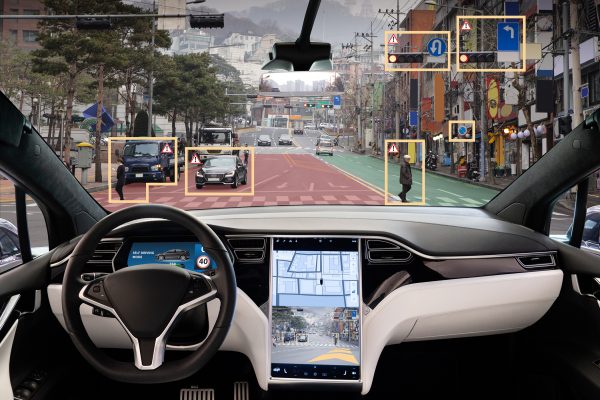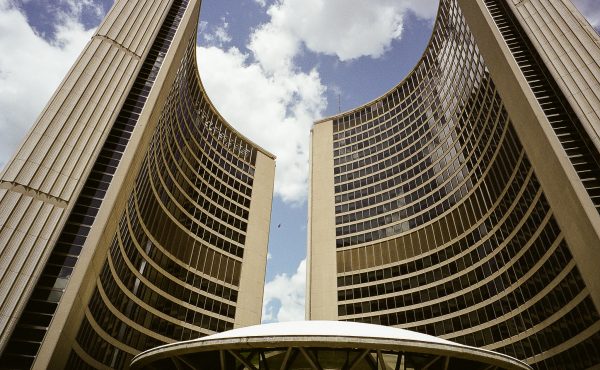
During a week when the city was buzzing with thousands of tech types here for the ritual in-gathering that is the Collision conference, it seems appropriate that Anthony Townsend, a smart city futurist and consultant, turned up at Evergreen on Tuesday to debunk some of the myth-making around driverless cars.
“What I want to show people is that this isn’t about cars,” he told me in an interview last week.
In his lectures about tomorrow, Townsend — who is the author of the 2013 book, Smart Cities: Big Data, Civic Hackers, and the Quest for a New Utopia — begins by talking about yesterday. He takes a stroll across large tracts of history and geography, demonstrating that humans have been fantasizing for a long time about being propelled without effort, either by animals, magic, slaves, and other devices.
In the post-WWII era, besotted as it was by visions of space age technology, those dreams found expression in experiments with auto-piloted or remote-control cars gliding along tidily sparse expressways. Townsend posits a continuum between all that distant and recent past, and our current period, characterized as it is by highly sophisticated navigation, mapping and sensing systems, artificial intelligence, and a sales pitch that emphasizes how autonomous vehicles (AVs) will provide new modes of urban transportation as well as independence to those who can’t drive.
Yet Townsend, who consulted for Sidewalk Labs before it selected Toronto for its smart city project, says the automobile industry and the likes of Uber have promoted the idea that AVs will be primarily cars. In his reading of the future, constantly evolving automation technology will trigger an “explosion” in the development of highly specialized electric, driverless vehicles of varying sizes and functions.
His examples include:
- “package bots,” which he depicts as automated carts that can hold one or two packages and are designed to tackle the vicious last-mile problem for e-commerce companies;
- “mules,” which are compact, self-driving cargo vans that will also play a role in the explosive growth of the e-commerce delivery infrastructure;
- driverless shuttle buses, which may become the workhorses of the local AV transit services being developed in cities such as Hamburg;
- self-driving bikes, e-bikes, and scooters, whose automation and gyroscope-based balancing systems can be used to provide or expand dockless bike-sharing services (as opposed to the more cumbersome varieties, such as Toronto’s, which rely on stations and the operational headache associated with moving unused bikes around the city).
Townsend also told me that he’s aware of researchers now developing “augmented feet” — essentially, inexpensive wearable mobility devices that will be made and marketed at the speed of the consumer electronics industry. “Over the next ten or 15 years,” he predicts, “you will get a whole array of these things and dozens of services, each targeting urban mobility needs.”
It’s always important to take prognosticators with a grain or two of salt, but the active development and early marketing of this wider array of technologies should signal municipal policy makers to begin thinking now about what urban transportation looks like in some version of Townsend’s future.
A good place to begin is to take careful note of the vast consequences of the original scalable mobility technology — the internal combustion engine. Indeed, scalability, to my eye, has become the most critical watchword in the deployment of any technology that aspires to act on urban spaces and systems.
I probably don’t need to enumerate examples of the cause-effect relationship between certain technologies and cities, but it’s worth doing anyway: Uber/Lyft and induced congestion; AirbNb/HomeAway and distorted rental apartment markets; Instagram and overwhelmed public/tourist spaces; Waze and neighbourhood traffic infiltration; e-scooters (Bird, et al) and head injuries. The list is long.
Some of the technologies currently in the urban mobility R&D pipeline seem utterly implausible, but almost all of the examples Townsend discussed point toward completely new ways of organizing the spaces in which human beings travel.
The current taxonomy of mobility space presents as a short list: streets, controlled access highways, sidewalks, paths, some bike lanes, and some dedicated transit corridors. But as anyone who’s cursed the stealthy presence of fast-moving e-bikes in bike lanes can attest, the introduction of machine powered mobility in zones set aside for human-powered movement spells conflict. The conflict will scale in direct proportion to the proliferation of these devices.
The future Townsend anticipates seems to require another zone, besides bike lanes, that would be set aside for devices that are too bulky, fast and powerful for sidewalks, but too small and vulnerable for roads. Far less clear is where municipal planners will find this additional space, and how they’ll design the ways in which it intersects with the other tendrils of the mobility network. Given the extreme challenges the City of Toronto faces with even the most modest changes in our transportation system (King Pilot, bike lanes, etc.), it’s difficult to imagine how this story plays out locally.
Then there are the social implications. How will inexpensive, mass marketed mobility devices impact population health? In too many communities, post-war planning systematically edited out opportunities to walk or ride from point A to point B, with all the associated implications for health. Does Townsend’s future perpetuate a long-term trend or amplify these patterns? And who should shoulder the externalized health care costs of technologies that render walking obsolete?
Lastly, there are the policing questions. If the accelerating tsunami of e-commerce parcel purchases ends up driving the deployment of automated delivery vehicles programmed to zip around neighbourhoods, is there a concomitant cost associated with protecting these gadgets and their payloads? Will the police be inundated with calls from click-addled consumers who’ve had their Amazon parcels hijacked en route (a variation of the porch-theft problem)? Or will Amazon be forced to equip its parcel bots/mules with AI-fueled security sensors designed to detect threats? It may be the case that the delivery guy, with his or her modest salary, plays a far more important function than just moving a van through city streets.
Are these even the right questions to ask? I don’t know, but what is certain is that the time to ask questions is now, i.e., at a point when the emergence of these technologies is discernible yet still somewhere off in the near future. Policy-making that reacts to rapidly scaling urban technologies — as happened with ride-hailing services and short-term rentals — is policy-making that has happened far too late. Indeed, I’d argue that the R&D/pilot project narrative mobility tech firms utilize should be mirrored by a parallel process for testing and evaluating public policy.
After all, the promoters of new technologies never envision congestion; rather, their sales pitches promise less congestion and greater ease of movement. But the well-documented history of tech scalability suggests a very different future.
We have no excuse not to think about the unintended consequences.





2 comments
The sooner driverless technology takes place the better off we will all be. Thousands of lives saved. Tens of thousands injuries eliminated. Free up hospital space for sick people. Eliminate thousands of tow truck bandits everywhere. Only flat tires and out-of-fuel calls needed. Greatly reduced insurance rates. Calm and quiet will take over from madness and horn honking. Bring it on!
Excellent piece, Lorinc! As a long-time Tokyo-based auto industry speechwriter and journalist, I’m hugely skeptical of the go-anywhere Uber AV model. But last-mile bus service on carefully groomed and sensored routes is coming, as Townsend says. I’d add to his list of “coming soon” AV is overnight truck convoys on expressways. Skeptical of AV but not skeptical of EV: the shift is going to come quick and massively once battery tech hits the tipping point.